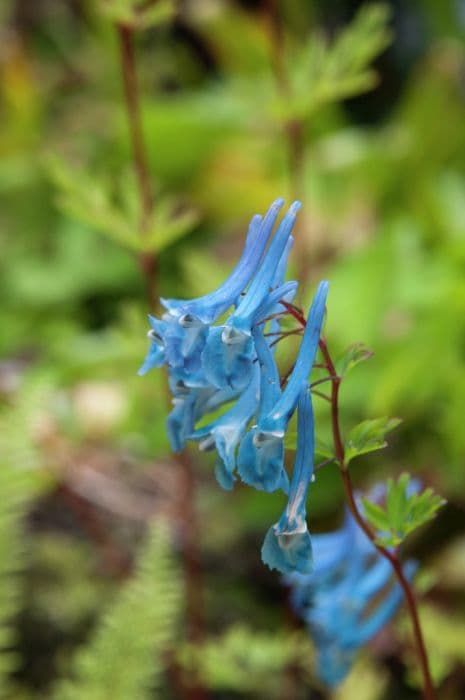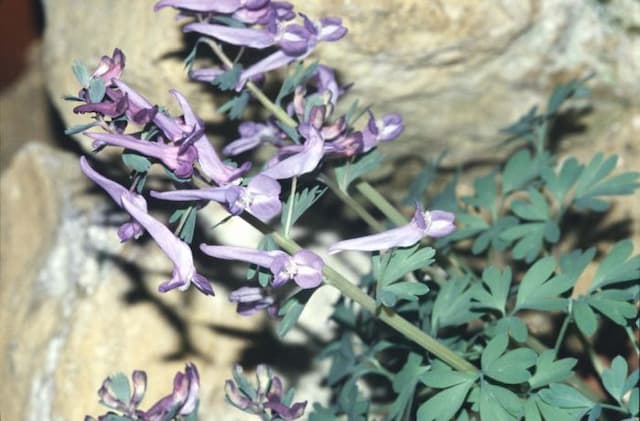Pacific Bleeding Heart Dicentra formosa 'Langtrees'

ABOUT
The Dicentra formosa 'Langtrees', also commonly known as the Pacific bleeding heart, is a perennial plant that is visually delightful and distinctive. It possesses a charming foliage that is fern-like, delicate, and bluish-green in color. These leaves provide a lovely backdrop for the plant’s most notable feature: its heart-shaped flowers. The elegant flowers dangle gracefully from arching stems, resembling small locks or charms. They are a soft white with notable tips that have a touch of pink, creating a subtle yet striking contrast against the foliage. The overall impression of the blooms is one of gentle romance and whimsy. Moreover, the leaves of Pacific bleeding heart often have a silver or grayish overlay, particularly on the veins, which adds a decorative variegation to the plant's appearance. This silver variegation distinguishes the 'Langtrees' variety from the more common, plain green versions of the same species. As the seasons change, this plant maintains its ornamental appeal. It's important to note that the Pacific bleeding heart has a natural rhythm where it can become dormant and reemerge with the returning spring, ready to unveil its delicate display once again.
About this plant
 Names
NamesFamily
Papaveraceae
Synonyms
Pacific Bleeding Heart, Western Bleeding Heart
Common names
Dicentra formosa 'Langtrees'.
 Toxicity
ToxicityTo humans
The plant commonly known as Western Bleeding Heart is considered toxic to humans if ingested. The toxicity is due to isoquinoline alkaloids it contains, which can cause symptoms such as nausea, vomiting, diarrhea, and in severe cases, seizures, respiratory distress, or even heart problems. It is important to handle this plant with care and ensure that it is not consumed by children or adults.
To pets
Western Bleeding Heart is also toxic to pets such as dogs and cats. The presence of isoquinoline alkaloids can lead to similar symptoms as in humans, including drooling, vomiting, diarrhea, and sometimes tremors or seizures in severe cases. If ingested, it is crucial to seek veterinary care immediately.
 Characteristics
CharacteristicsLife cycle
Perennials
Foliage type
Deciduous
Color of leaves
Green
Flower color
Pink
Height
1-2 feet (30-60 cm)
Spread
1-2 feet (30-60 cm)
Plant type
Herb
Hardiness zones
3-9
Native area
Western North America
Benefits
 General Benefits
General Benefits- Aesthetic Appeal: Dicentra formosa 'Langtrees', commonly known as Western Bleeding Heart, offers delicate, heart-shaped flowers that can add a romantic touch to gardens or landscapes.
- Shade Tolerance: This plant is well-suited for shaded or semi-shaded areas, making it versatile for different garden locations where sunlight is limited.
- Drought Resistance: Once established, Western Bleeding Heart can be quite drought tolerant, reducing the need for frequent watering.
- Attracts Pollinators: The flowers attract bees, butterflies, and other pollinating insects, which are beneficial for the garden ecosystem.
- Deer and Rabbit Resistant: Its foliage is generally resistant to deer and rabbits, making it a good choice in areas where these animals are a problem.
- Easy to Grow: This plant is considered low maintenance and is relatively easy to grow, which is ideal for novice gardeners or those with limited time.
- Spring Bloom: It produces blooms in the spring, helping to provide early color and interest in the garden after winter.
- Naturalizing: Western Bleeding Heart can spread and naturalize in an area, creating larger patches of coverage without the need for replanting.
 Medical Properties
Medical PropertiesThis plant is not used for medical purposes.
 Air-purifying Qualities
Air-purifying QualitiesThis plant is not specifically known for air purifying qualities.
 Other Uses
Other Uses- Photography Subject: Pacific Bleeding Heart's distinct heart-shaped flowers and attractive foliage make it a popular subject for both amateur and professional photographers creating botanical portfolios.
- Art and Illustration: With its unique appearance, Pacific Bleeding Heart is often used as a model for botanical illustration and watercolor painting, inspiring many artists.
- Educational Tool: Botany educators may use Pacific Bleeding Heart to introduce students to plant biology and the ecological role of native species in their habitats.
- Theme Gardens: It can be included in 'love' or 'heart' themed gardens due to the heart shape of its flowers, often in conjunction with Valentine's Day celebrations.
- Nature-Inspired Design: Its distinctive shape and color scheme may be used as inspiration for design in fashion, jewelry, or decorative arts.
- Fairy and Miniature Gardens: Due to its delicate appearance, Pacific Bleeding Heart is often used in miniature gardens intended to evoke a fairy-like or whimsical ambiance.
- Erosion Control: The plant can be involved in soil stabilization projects on shaded slopes because it is a good ground cover that can help manage erosion.
- Wildlife Attraction: In garden landscaping, it is used to attract pollinators like bees and butterflies, which find its flowers appealing.
- Eco-friendly Gift: Offered as a sustainable gift option, Pacific Bleeding Heart is a plant that keeps on giving by contributing to the local ecosystem when planted outdoors.
- Wedding Decorations: The romantic symbolism of Pacific Bleeding Heart makes it a candidate for use in eco-friendly wedding decorations, especially for woodland or garden-themed weddings.
Interesting Facts
 Feng Shui
Feng ShuiThe plant Bleeding Heart is not used in Feng Shui practice.
 Zodiac Sign Compitability
Zodiac Sign CompitabilityThe plant Bleeding Heart is not used in astrology practice.
 Plant Symbolism
Plant Symbolism- Love and Romance: Often known by its common name "Bleeding Heart," Dicentra formosa 'Langtrees' typically symbolizes deep emotions and often express feelings of love and romance, stemming from its heart-shaped flowers.
- Compassion and Empathy: The 'Bleeding' aspect of the Bleeding Heart may represent compassion and empathy, suggesting a nature that is sensitive to others' feelings.
- Elegance and Grace: With its arching stems and delicate foliage, the Bleeding Heart is also associated with elegance and grace.
- Rejected Love: Because the heart-shaped flowers appear torn or "bleeding," they can symbolize the pain or sadness of rejected love.
 Water
WaterThe Western bleeding heart should be watered deeply once a week, allowing the soil to dry out slightly between waterings. During the growing season, especially in dry conditions, it may require additional water, potentially up to twice a week. Provide approximately 1-2 inches of water each time, which equates to about 1/2 to 1 gallon for small to medium-sized plants. It's important not to overwater, as the Western bleeding heart does not tolerate soggy soil, which can lead to root rot. During winter, water sparingly since the plant is dormant and its water requirements are minimal.
 Light
LightWestern bleeding heart thrives in partial shade with filtered sunlight, making it an ideal plant for woodland gardens or dappled shade areas. Direct afternoon sun can be too harsh and may cause leaf scorch, so morning sun or a location that receives dappled sunlight throughout the day is perfect. If grown indoors, place the plant in a spot where it will receive bright, indirect light for the majority of the day.
 Temperature
TemperatureWestern bleeding heart prefers cooler temperatures and can tolerate a range from 40 to 75 degrees Fahrenheit. It can survive brief periods of colder weather, as low as 20 degrees Fahrenheit, but sustained frost may damage the plant. Ideally, keep the Western bleeding heart in an environment where the average temperature hovers around 60 to 70 degrees Fahrenheit for optimal growth.
 Pruning
PruningPruning the Western bleeding heart is usually done to maintain its shape and remove spent flowers, which can encourage a second bloom. It should be pruned after flowering, typically in late spring or early summer. Cut back the foliage to the ground in fall after it has died back naturally. This helps prevent disease and encourages a tidy appearance.
 Cleaning
CleaningAs needed
 Soil
SoilPacific Bleeding Heart (Dicentra formosa 'Langtrees') thrives in moist, well-draining, humus-rich soil with a pH ranging from 6.0 to 7.0. A blend of equal parts loam, peat, and sand or perlite would create an ideal environment for this shade-loving perennial.
 Repotting
RepottingPacific Bleeding Heart should be repotted every 2-3 years to refresh the soil and accommodate growth. This also provides an opportunity to divide the plant for propagation if it has grown sufficiently.
 Humidity & Misting
Humidity & MistingPacific Bleeding Heart prefers moderate to high humidity conditions. Aim for a humidity level of 50-70% for optimal growth, though the plant can tolerate slightly lower humidity levels if necessary.
 Suitable locations
Suitable locationsIndoor
Keep Pacific Bleeding Heart in filtered light with moist soil.
Outdoor
Partial shade, organic-rich soil, water when topsoil dries.
Hardiness zone
3-9 USDA
 Life cycle
Life cycleDicentra formosa 'Langtrees', commonly known as Western bleeding heart, begins its life cycle as a seed that germinates in moist, cool conditions, typically in early spring. The seedlings develop into clumps of fern-like foliage, from which graceful, arching stems arise, bearing distinctive heart-shaped flowers that are white with a touch of blue-green, usually blooming from late spring to early summer. Post-flowering, the plant produces seed pods that ripen, eventually drying and releasing seeds by late summer or fall. As a perennial, after the flowering and seed dispersal, the above-ground parts of the plant die back to the ground, while the root system remains viable, storing energy for the next growing season. The plant enters a period of dormancy during winter, with growth resuming in the following spring as temperatures increase and the soil warms. Throughout its life, Western bleeding heart can also spread vegetatively by underground rhizomes, creating larger clumps and expanding its presence in the garden over the years.
 Propogation
PropogationPropogation time
Spring to early summer
The most popular method for propagating the Pacific Bleeding Heart, Dicentra formosa 'Langtrees', is through division. The best time to do this is in the early spring or autumn when the plant is dormant. To propagate by division, carefully dig up the clump of the plant, ensuring that you take a substantial amount of roots. Gently tease apart the clump into smaller sections, making sure each new section has several growth points or buds. Replant each division immediately, spacing them about a foot (approximately 30 centimeters) apart to ensure sufficient room for growth. Water the new plantings thoroughly to help establish the roots. This method allows for quick multiplication of the plant and maintains the characteristics of the 'Langtrees' variety.









